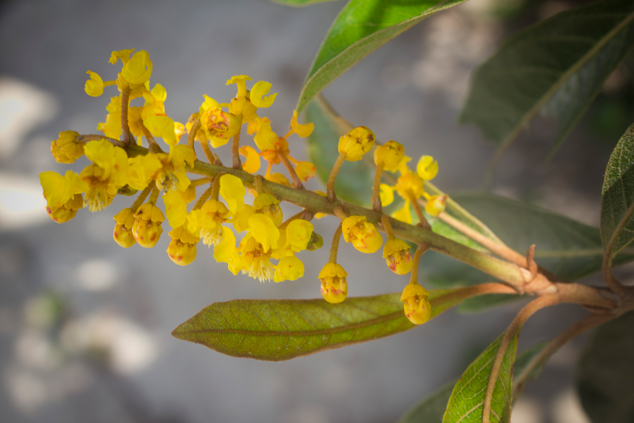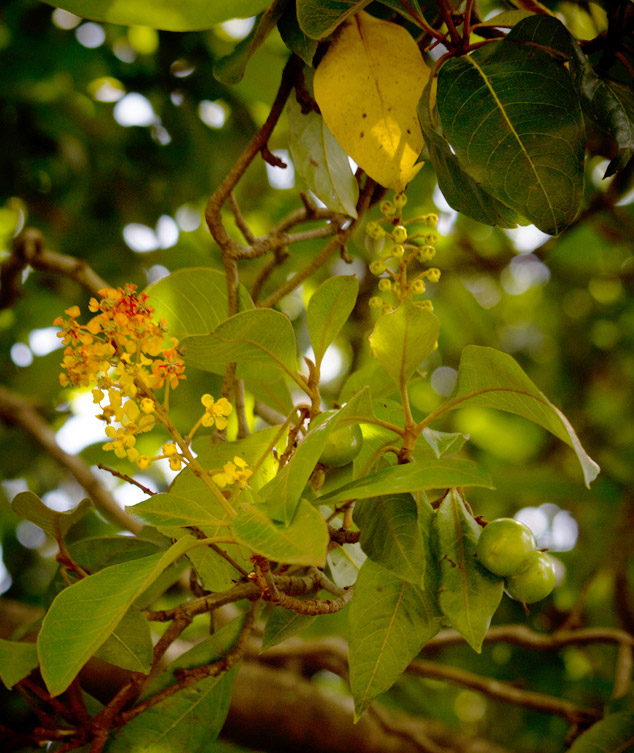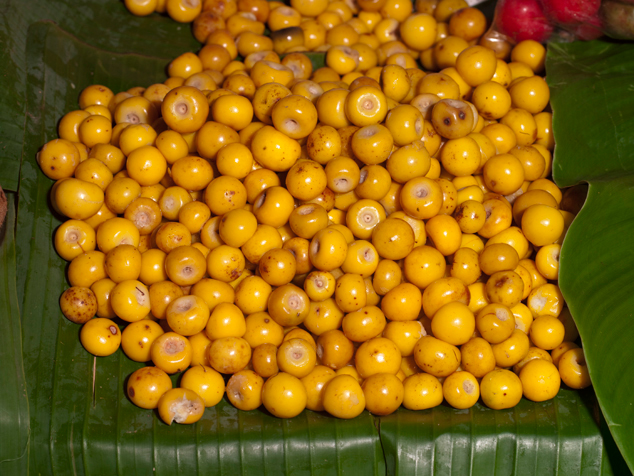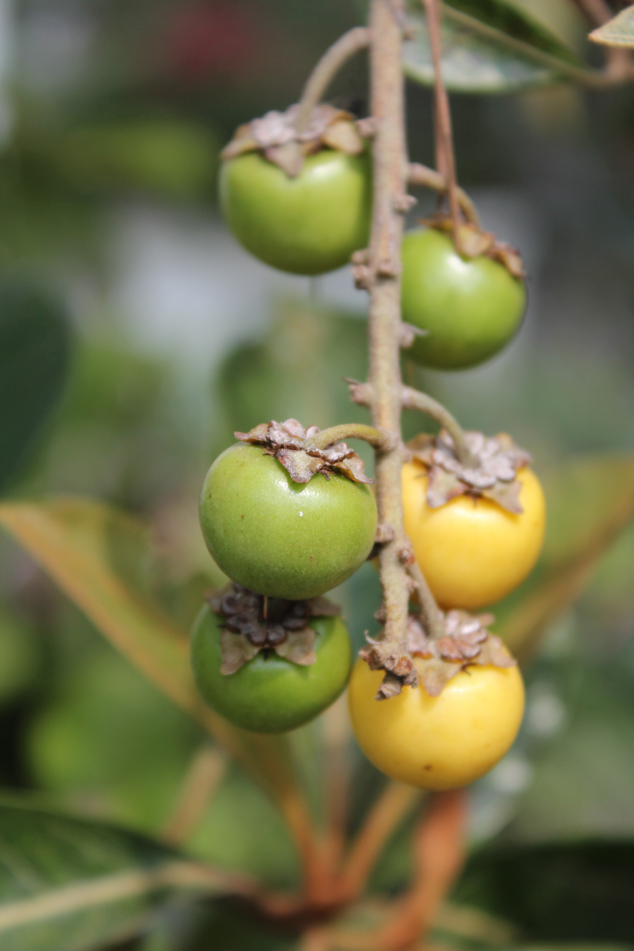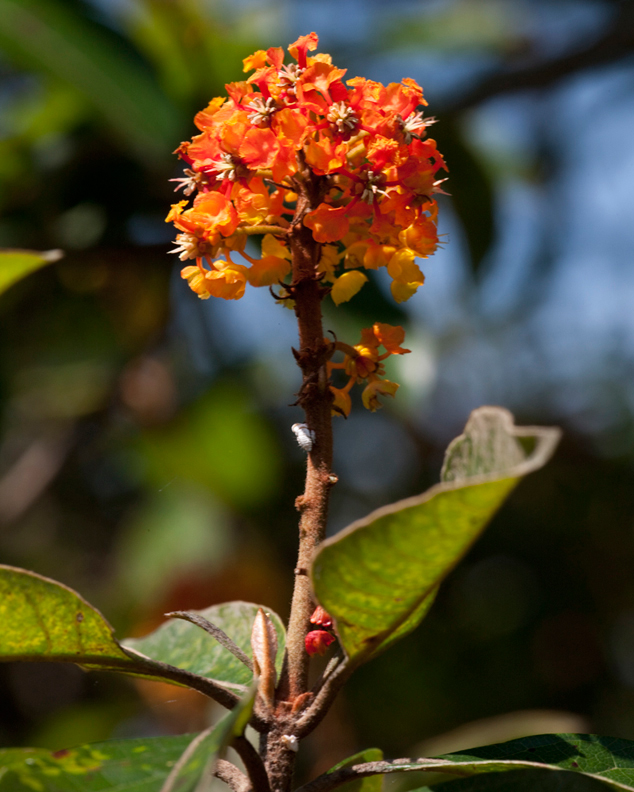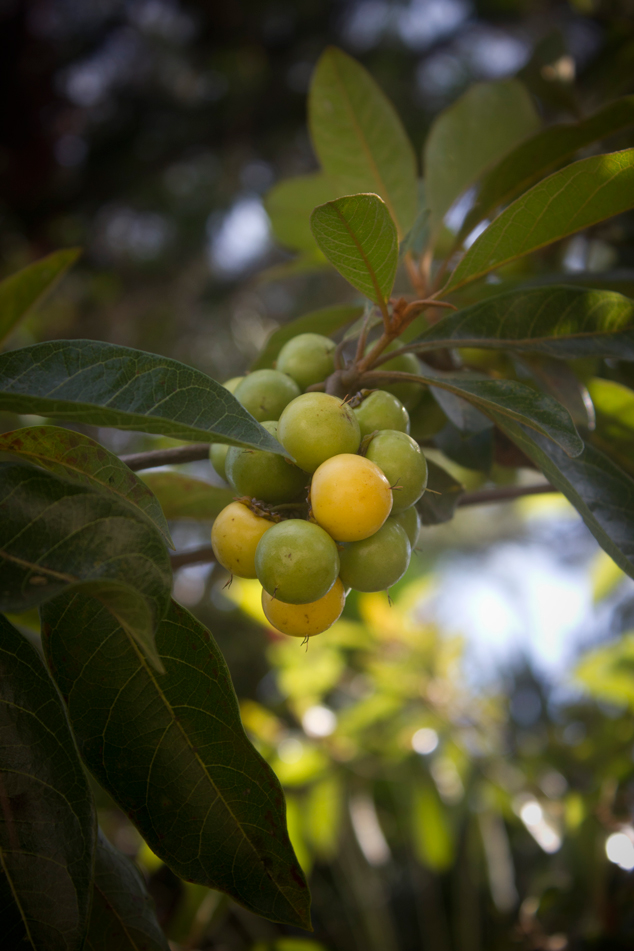The Nance tree was the perch for 7 Macaw in the Popol Vuh
The nance tree is explicitely listed as the favorite perch for 7 Macaw in the Popol Vuh, but in reality this is an unexpected perch for a macaw. In ancient Mayan art the magnificent Principal Bird Deity perches in trees other than nance! Plus the mythical bird monster in a thousand years of Preclassic and Classic Maya art is a snake-eating falcon or hawk. Only at Copan is the bird more macaw-like. In the Copan ballcourt stucco reliefs the macaw-bird deity even holds the severed arm of the Maya hero.
Another slight issue is that according to botanists, the nance tree is supposed to be a savanna tree but all the nance trees I know are in home gardens, far from any savanna. Or in pastures that were once verdant rain forests (again, not a dry savanna).
Introduction to Nance
Nance, Byrsonima crassifolia, is the size of a very small cherry. It is ready to harvest when yellow. Everywhere I go in Guatemala local people speak about two kinds: bitter and sweet.
Uses
The wood of this plant is used in simple constructions. A crust properties are attributed acaricides, antitussive, astringent, healing. Fruits and their peels are used for dyeing cotton as well as the bark contains tannins. Of fruits and alcoholic beverages are used to make desserts.
Where to find nance trees in Guatemala
The tree is relatively common. You can find the yellow berries in local markets in Antigua Guatemala and Coban, Alta Verapaz. We found them in the markets during Semana Santa and also in early June.
We found several nance trees blooming by mid-June. One was past its prime; another (Rio de los Esclavos) was in full bloom. One in Sofia's garden was bearing mature fruit. So within a same week, status will differ considerably depending on elevation, soil, and rainfall.
One tree was a full-sized tree, with most of the flowers far too high up to photograph, even with telephoto lenses.
Nance flower Blooming, El Cerinal, Barberena, Santa Rosa, Guatemala 2011.
Nance's Small and Blooming flower with fruit in tree, El Cerinal, Barberena, Santa Rosa, Guatemala 2011.
Thesis potential: nance as a commercial crop
Nance could be better commercialized, but it would be a challenge. I will admit I have never been inspired to eat nance fruits. My main interest in this fruit is because I find it an unlikely perch for the giant 7 Macaw (the false sun deity). This is one of the more commonly depicted avian monsters in Early Classic and even Late Classic Mayan art of Guatemala and Honduras.
The question for a thesis or research project would be, are there any hawks, eagles that favor a nance tree, either to eat the fruit or because the fruit attracts smaller animals that the hawk or eagle can eat? In other words, I believe the bird monster is carnivorous, not a vegetarian (or at least omnivorous, eating both meat and nance fruit).
And, if the original model really was a macaw, in which part of Mexico, Guatemala, Belize, or Honduras would a macaw favor a nance tree as a perch?
Nance (Byrsonima crassifolia) at a market in Guatemala, FLAAR Photo Archive
Mature and green nance fruit , El Cerinal, Barberena, Santa Rosa, Guatemala 2011
Thesis potential: nance as the home of Seven Macaw
But what if there were snakes that fed on rodents which were attracted to the fallen nance fruits that littered the ground? These snakes would then indeed attract a snake-eatting hawk or falcon to the tree.
Here is what we know about the nance tree from the Popol Vuh.
This is Seven Macaw and a great nance tree.180 This, then, is the food of Seven.
Macaw. Each day he would rise up to the top of the tree to knock down some of the fruit of the nance tree, and it is there that he was seen by Hunahpu and Xbalanque.
The twins watched for him beneath the tree, hidden in its leaves. At length Seven Macaw perched on the nance tree to feed and was shot by them. Hunahpu181 directed a pellet straight from his blowgun into his jaw. Seven Macaw cried out,182 sailing over the top of the tree and landing on the ground.
Quickly, Hunahpu ran out to grab him. But instead Seven Macaw tore off the arm of Hunahpu. He wrenched it back, bending it back at the shoulder until it was torn free from Hunahpu. (Allen Christenson).
I would enjoy hearing from a linguist whether the Seven Macaw is "knocking down" nance in the sense of eating the nance fruit, or whether the bird is literally knocking the nance down to the ground to attract rodents and snakes so the bird can then gobble up fresh meat!.
There is another instance of a raptor in the Popol Vuh, the one that eats the snake messenger. Bassie 2007 (in a review of the excellent translation of the Popol Vuh by Allen Christenson, 2003) suggests the snake messenger is the snake in the mouth of the Principal Bird Deity. I disagree because there is a Maya scene (that I illustrated in my PhD dissertation already back in 1985, published in 1987: page 251, Abb, 547) that clearly depicts the snake-eating bird messenger, complete with the toad or frog (that ate the louse). This messenger bird is naturalistic: it is not the False Sun of the Popol Vuh.
Snake-eating birds
The giant bird monster of the Early Classic is clearly eating snakes: it is not a vegetarian.
When I Googled snake eating bird Guatemala, I got scores of web sites that all repeated the same statement, that Guatemala may derive its name from the Nahuatl word coactlmoctl-lan, meaning " land of the snake-eating bird." (Wikipedia). It would be remarkably appropriate if Guatemala were named after the snake-eating bird of all the Early Classic pottery scenes that I show in my PhD dissertation (1985; published in 1987).
I have always thought that Guatemala meant the land of trees: the Aztec word Quauhtlemallan, meaning "Land of many trees. "
The myth of the Popol Vuh comes to us from the Quiche area of Guatemala which is in the Highlands. I doubt nance trees prosper at this altitude. But long ago scholars realized that most of the plants and animals featured in the story told by the Popol Vuh are from the humid tropical Lowlands (where nance trees can be at home).
And the earliest artistic renditions of a giant deity bird monster featured up in a tree, are on the carved stone stelae of Izapa (near Tapachula, Chiapas, near the border of Mexico with Guatemala, not far from the Pacific Ocean). On these Preclassic stelae the bird is perched atop a Crocodile Tree, which is definitely not a nance tree (we at FLAAR have long ago figured out what species is represented by the crocodile tree, and the story is far more complex than it being a simple ceiba).
In the Preclassic murals of San Bartolo, El Peten, again the bird deity is not in a nance tree, but atop a morro or jicaro tree. So clearly the bird monster can be at home in whichever tree happens to be favored for special reasons of interest to the particular time, place, or culture that is packaging the myth for local consumption.
So we should not worry excessively about which trees the bird is perched on. Most important is the species of bird, rather than the species of tree. And if Guatemala really means "land of the snake-eating bird" this would fit in fabulously with the Popol Vuh (since the Izapa stelae are only a few kilometers away from the modern Guatemalan border).
Nance with red and yellow flowers, FLAAR Photo Archive
Nance fruits, green and mature, hanging in the tree, El Cerinal, Barberena, Santa Rosa, Guatemala 2011
Biblioweb
www.worldagroforestrycentre.org/sea/Products/AFDbases/AF/asp/SpeciesInfo.asp?SpID=17946
Basic but helpful; however no illustrations whatsoever
www.hort.purdue.edu/newcrop/morton/nance.html
Although only equivalent to about two pages, and though with only one dull B&W photo, the description is helpful.
Last update 12 August 2011.
First posted July 07, 2011.


